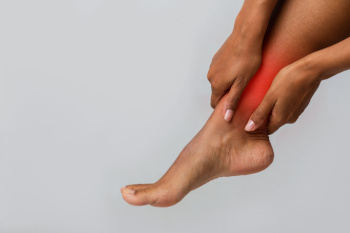
Waking up with ankle pain can be caused by several factors. One common reason is the dawn phenomenon, which refers to increased inflammation and stiffness that occurs in the early morning, often due to the body’s natural circadian rhythms. Arthritis, particularly osteoarthritis, can lead to morning ankle pain as the joints become stiff overnight, making movement difficult. Inflammation caused by overuse, poor posture, or injury can also contribute to discomfort. Plantar fasciitis, a condition that affects the bottom of the foot, can also cause pain in the ankle area, especially in the morning when taking the first few steps. This pain is often sharp and decreases with movement as the tissues loosen up. If you are experiencing any type of ankle pain, it is strongly suggested that you contact a podiatrist who can determine what the cause is, and offer appropriate treatment solutions.
Ankle pain can have many different causes and the pain may potentially be serious. If you have ankle pain, consult with William Beaton, DPM from Advanced Podiatry and Wound Care. Our doctor will assess your condition and provide you with quality foot and ankle treatment.
Ankle pain is any condition that causes pain in the ankle. Due to the fact that the ankle consists of tendons, muscles, bones, and ligaments, ankle pain can come from a number of different conditions.
Causes
The most common causes of ankle pain include:
- Types of arthritis (rheumatoid, osteoarthritis, and gout)
- Ankle sprains
- Broken ankles
- Achilles tendinitis
- Achilles tendon rupture
- Stress fractures
- Tarsal tunnel syndrome
- Plantar fasciitis
Symptoms
Symptoms of ankle injury vary based upon the condition. Pain may include general pain and discomfort, swelling, aching, redness, bruising, burning or stabbing sensations, and/or loss of sensation.
Diagnosis
Due to the wide variety of potential causes of ankle pain, podiatrists will utilize a number of different methods to properly diagnose ankle pain. This can include asking for personal and family medical histories and of any recent injuries. Further diagnosis may include sensation tests, a physical examination, and potentially x-rays or other imaging tests.
Treatment
Just as the range of causes varies widely, so do treatments. Some more common treatments are rest, ice packs, keeping pressure off the foot, orthotics and braces, medication for inflammation and pain, and surgery.
If you have any questions, please feel free to contact our office located in St. Petersburg, FL . We offer the newest diagnostic and treatment technologies for all your foot care needs.
